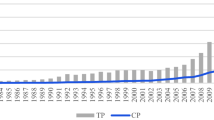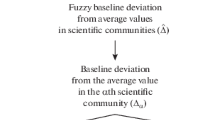Abstract
Determining the core of a field"s literature, i.e. its "most important" sources, has been and still is an important problem in bibliometrics. In this article an exact definition of a core of a bibliography or a conglomerate is presented. The main ingredients for this definition are: fuzzy set theory, Lorenz curves and concentration measures. If one prefers a strict delineation, the fuzzy core can easily be defuzzified. The method we propose does not depend on the subjective notion of "importance". It is, moreover, completely reproducible. The method and the resulting core is also independent of the mathematical function (Lotka, Zipf, Bradford, etc.) that may be used to describe the relation between the set of sources and that of items.
Similar content being viewed by others
References
Arora, J., U. Pawan (1995), Core journals in immunology: correlation analysis: rank v/s rank and rank v/s impact factor, JISSI: The International Journal of Scientometrics and Informetrics, 1(2): 83-97.
Bonitz, M., E. Bruckner, A. Scharnhorst (1999), The Matthew Index-concentration patterns and Matthew core journals, Scientometrics, 44: 361-378.
Bradford, S. C. (1934), Sources of information on specific subjects, Engineering, 137: 85-86.
Brookes, B. C. (1969), Bradford's law and the bibliography of science, Nature, 224: 953-956.
Brookes, B. C. (1984), Towards informetrics: Haitun, Laplace, Zipf, Bradford and the Alvey programme, Journal of Documentation, 40: 120-143.
Brooks, T. (1989), Core journals of the rapidly changing research front of “superconductivity”, Communication Research, 16: 682-694.
Chu, C. M., D. Wolfram (1991), A survey of the growth of Canadian research in information science/Une enquête sur la croissance de la récherche canadienne en science de l'information, The Canadian Journal of information Science/Revue canadienne des sciences de l'information, 16: 12-28.
Dresden, A. (1922), A report on the scientific work of the Chicago section, 1897-1922, American Mathematical Society Bulletin, 28: 303-307.
Egghe, L. (1990), Applications of the theory of Bradford's law to the calculation of Leimkuhler's law and to the completion of bibliographies, Journal of the American Society for information Science 41: 469-492.
Egghe, L. (1998), The evolution of core collections can be described via Banach space valued stochastic processes, Mathematical and Computer Modelling, 28: 11-17.
Egghe, L. (2001a), Construction of concentration measures for general Lorenz curves using Riemann-Stieltjes integrals, Mathematical and Computer Modelling (to appear).
Egghe, L. (2001b), Sampling and concentration values of incomplete bibliographies, Journal of the American Society for Information Science and Technology (to appear).
Egghe, L., R. Rousseau (1990), Introduction to Informetrics Amsterdam: Elsevier.
Egghe, L., R. Rousseau (2000), Aging, obsolescence, impact, growth and utilization: definitions and relations, Journal of the American Society for Information Science, 51(11): 1004-1017.
Egghe, L., R. Rousseau (2001), Symmetric and asymmetric theory of relative concentration, Scientometrics 52: 261-290.
Jacobi, K. P., K. B. Propst (1989), Anthropological Linguistics: thirty-year index (1959-1988), Anthropological Linguistics, 31: 3-52.
Jin, B., J. Zhang, D. Chen, X. ZHU (2002), Development of the Chinese Scientometric Indicators (SCI), Scientometrics 54: 145-154.
Joswick, K. E., J. K. Stierman (1997), The core list mirage: a comparison of the journals frequently consulted by faculty and students, College & Research Libraries, 58: 48-55.
Kendall, M. G. (1960), The bibliography of operational research, Operational Research Quarterly, 11: 31-36.
Kinnucan, M., M. N ELSON, B. A LLEN (1987), Statistical methods in information science research, Annual Review of Information Science and Technology, 22: 147-178.
Mccain, K. (1995), Biotechnology in context: a database-filtering approach to identifying core and productive non-core journals supporting multidisciplinary R&D, Journal of the American Society for Information Science, 46: 306-317.
Mccain, K. (1997), Bibliometric tools for serials collection management in academic libraries, Advances in Serials Management, 6: 105-146.
Murphy, L. J. (1973), Lotka's law in the humanities? Journal of the American Society for Information Science, 24: 461-462.
Nieuwenhuysen, P. (1988), A bibliography of text information management software for IBM microcomputers and compatibles, The Electronic Library, 6: 264-320.
Nijssen, D., R. Rousseau, P. Van Hecke (1998), The Lorenz curve: a graphical representation of evenness, Coenoses, 13: 33-38.
Pao, M. L. (1979), Bibliometrics and computational musicology, Collection Management 3: 97-109.
Penrose, R. (1990), The emperor's new mind Vintage: New York.
Peritz, B. C. (1984), On the careers of terminologies; the case of bibliometrics, Libri, 34: 233-242.
Pope, A. (1975), Bradford's law and the periodical literature of information science, Journal of the American Society for Information Science, 26: 207-213.
Prather, R. E. (1988), Comparison and extension of theories of Zipf and Halstead, The Computer Journal, 31: 248-252.
Radhakrishnan, T., R. Kerdizan (1979), Lotka's law and computer science literature, Journal of the American Society for Information Science, 30: 51-54.
Rao, I. K. R. (1990), Journal productivity in economics, Informetrics 89/90 (Egghe and Rousseau, Eds), Amsterdam: Elsevier, 251-280.
Rice, R. E., C. L. Borgman, D. Bednarski, P. J. Hart (1989), Journal-to-journal citation data: issues of validity and reliability, Scientometrics, 15: 257-282.
Rousseau, R. (1987), The nuclear zone of a Leimkuhler curve, Journal of Documentation 43: 322-333.
Rousseau, R. (1992), Concentration and diversity measures in informetric research Doctoral dissertation, University of Antwerp.
Rousseau, R. (1993), Determination of a core of a bibliography, Iaslic Bulletin, 38: 49-57; 166a-166c.
Rousseau, R. (1994), Bradford curves, Information Processing and Management, 30: 267-277.
Rousseau, R. (1997), Sitations: an exploratory study, Cybermetrics, 1(1), http://www.cindoc.csic.es/cybermetrics/articles/v1i1p1.html
Rousseau, R. (2000), Concentration and evenness measures as macro-level scientometric indicators. Paper presented at the Second International Symposium on Quantitative Evaluation of Research Performances and Sixth National Conference on Scientometrics and Informetrics (October 23-25, 2000, Shanghai, China).
Schorr, A. E. (1975), Lotka's law and map librarianship, Journal of the American Society for Information Science, 26: 189-190.
Seley, H. (1968), The mast cells. London: Butterworth.
Shukla, M. C. (1996), Publication patterns in the field of renewable energy. An analysis of Indian Energy Abstracts. In: Handbook of Libraries, Archives & Information Centres in India. Volume 13, B. M. Gupta (Ed.), Segment Books: New Delhi, 309-328.
Slater, B. M., M. A. Slater (1994), Determining core journals in behavioral medicine, Bulletin of the Medical Library Association, 82: 70-72.
White, H. D., K. Mccain (1989), Bibliometrics, Annual Review of Information Science and Technology, 24: 119-186.
Zadeh, L. (1965), Fuzzy sets, Information and Control, 8: 338-353.
Zhang, Q. (1992), The literature of rice: a bibliometrics survey, IAALD Quarterly Bulletin, 37: 151-158.
Author information
Authors and Affiliations
Rights and permissions
About this article
Cite this article
Egghe, L., Rousseau, R. A proposal to define a core of a scientific subject: A definition using concentration and fuzzy sets. Scientometrics 54, 51–62 (2002). https://doi.org/10.1023/A:1015680304126
Issue Date:
DOI: https://doi.org/10.1023/A:1015680304126




